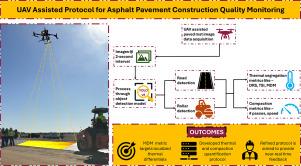利用无人机图像评估沥青路面施工的自动化框架
IF 11.5
1区 工程技术
Q1 CONSTRUCTION & BUILDING TECHNOLOGY
引用次数: 0
摘要
热均匀性和就地密度是影响新铺沥青路面性能的关键质量保证因素。现有的技术,如摊铺机热剖面仪和智能压实技术,可以量化热不均匀性和密度差异。本文提出了一种利用无人机(UAV)辅助航空红外(IR)图像数据的替代协议。开发了一个深度学习对象检测模型,使用YOLOv8模型识别每个热图像中铺装垫和滚轮的位置。开发的框架用于2023年和2024年访问的各种站点。在所有站点的热图像中比较了热分离的三个量化指标——差距统计(DRS)、热分离指数(TSI)和Mat温差矩阵(MDM)。本文提出了一个基于实验场地数据的案例研究,并对两条车道的滚子运动进行了监测。从开发的协议中获得了诸如总体辊道数、辊道速度和基于底部分位数数据的辊道不足等压实指标。提出的框架成功地识别和映射辊的运动,同时计算热离析和压实指标。当在施工过程中进行现场处理时,这些指标可以近乎实时地了解铺路过程中垫子的不均匀性。该开发的协议可以为施工现场的承包商/代理提供可操作的反馈,并有助于提高施工质量的整体一致性。本文章由计算机程序翻译,如有差异,请以英文原文为准。

Automated framework for evaluating asphalt pavement construction using UAV imagery
Thermal uniformity and in-place density are key quality assurance factors affecting freshly placed asphalt pavement (referred to as mat) performance. Existing techniques like Paver Mounted Thermal Profilers and Intelligent Compaction Technologies quantify thermal non-uniformities and density differentials. In this paper, an alternative protocol was developed using unmanned aerial vehicle (UAV) assisted aerial infrared (IR) image data. A deep-learning object detection model was developed to identify the location of the paved mat and rollers in each thermal image using the YOLOv8 model. The developed framework was used for various sites visited in 2023 and 2024. Three quantification metrics for thermal segregation—Differential Range Statistic (DRS), Thermal Segregation Index (TSI), and Mat Temperature Differential Matrix (MDM)—are compared across all sites’ thermal images. A case study based on data from an experimental site is presented, and two lanes were monitored for roller movements. Compaction metrics such as the overall roller pass counts, roller speed, and insufficient roller passes based on the bottom quantile data were obtained from the developed protocol. The presented framework successfully identifies and maps the roller movements while calculating the thermal segregation and compaction metrics. When processed in the field during construction, the metrics can give near-real-time insights into the mat’s non-uniformities during paving. This developed protocol can provide actionable feedback to the contractors/agencies on the job site and help improve overall consistency in the quality of construction.
求助全文
通过发布文献求助,成功后即可免费获取论文全文。
去求助
来源期刊

Automation in Construction
工程技术-工程:土木
CiteScore
19.20
自引率
16.50%
发文量
563
审稿时长
8.5 months
期刊介绍:
Automation in Construction is an international journal that focuses on publishing original research papers related to the use of Information Technologies in various aspects of the construction industry. The journal covers topics such as design, engineering, construction technologies, and the maintenance and management of constructed facilities.
The scope of Automation in Construction is extensive and covers all stages of the construction life cycle. This includes initial planning and design, construction of the facility, operation and maintenance, as well as the eventual dismantling and recycling of buildings and engineering structures.
 求助内容:
求助内容: 应助结果提醒方式:
应助结果提醒方式:


